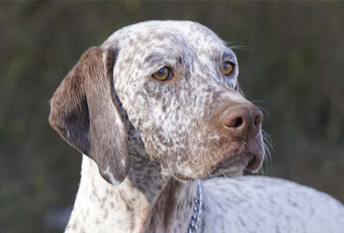Portuguese Pointers require minimal grooming due to their short, tight coats, but they all seem to enjoy a nice brushing with a rubber curry-type brush anyway, which also helps remove dead hair. In general, their hard coat is good at repelling dirt, so frequent baths are not needed.Routine attention to nails,teeth, and ears is expected.
Energetic and active dogs, Portuguese Pointers require at least an hour’s worth of heavy-duty exercise daily. When hunting season is over, this breed will enjoy playing ball, hide and seek and even Frisbee.
The important thing is that he is active or this breed can become destructive. Boredom is the downfall to the Portuguese Pointer. Without physical and mental stimuli, this dog will destroy your home and possessions. An active owner is absolutely necessary for the Portuguese Pointer.
The Portuguese Pointer is a high-energy dog and requires a high-quality diet to meet his nutritional needs.Like all canines, this breed will also require a well-balanced ratio of meat-based proteins, healthy fats, complex carbs and a variety of vitamins and minerals to truly thrive.
Most experts agree that these requirements are met withpremium dry food for dogs. Kibble contains all the important nutrients and it is a convenient way to get your dog all of the diverse ingredients they need to be healthy. For a dog such as the Portuguese Pointer, medium dog breed formula or formula for active, athletic dogs work best. In addition to choosing kibble that suits their size and activity level, make sure that it is age appropriate as well. Puppies, adults, and seniors all have different dietary needs.
Some breeders also recommend feeding food prepared at home, whether cooked or raw. However, if you decide to go with this route, it is crucial to have your veterinarian’s approval and guidance. Canine nutrition is complex and it’s easy to miss important nutrients or to overfeed your dog- obesity is a serious issue for these active dogs.
Portuguese Pointers are generally a very robust, healthy breed.There are no health issues specific to the breed, though care should be takento ensure breeding dogs and their relatives are free of known health issuesincluding seizures, hip dysplasia, and early-onset cancers or autoimmunediseases.
Portuguese Pointers have a desire to please their owners. They are highly trainable, but will resist training if done in a harsh manner. Only positive training techniques should be implemented when working with this breed. Extreme praise and tempting treats will entice the Portuguese Pointer into performing the behavior that you are soliciting from him. With consistency and patience, the dog will quickly learn the tricks or tasks that are required of him.
A gundog with impeccable instincts, the Portuguese Pointer needs little training to perform his instinctive duties. His ability to spot, detect and point out prey is favored by hunters. The closer connection the hunter has to the dog, the more in tune he will be with his signals.











